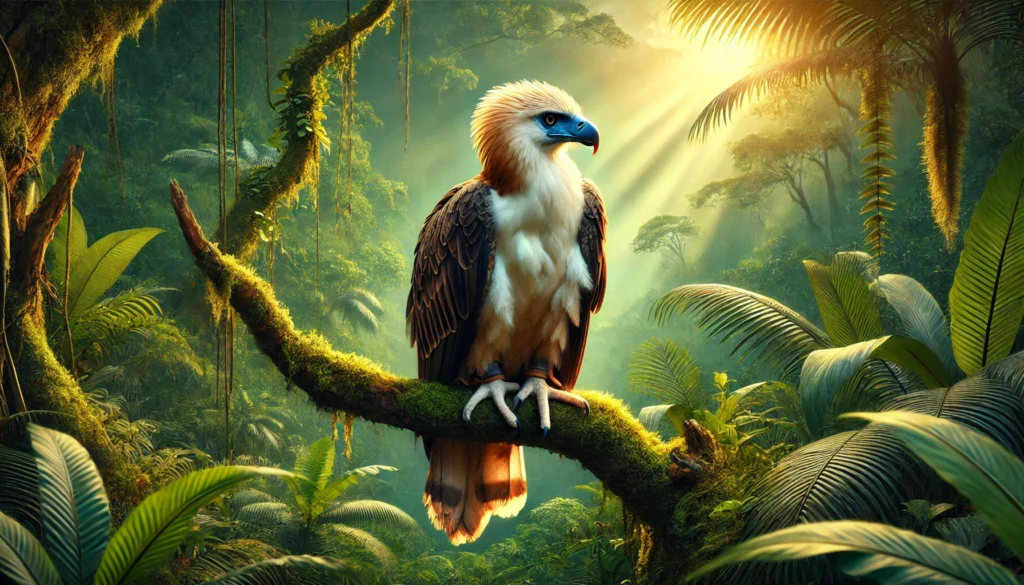Have you ever wondered what it would be like to soar through the lush Philippine forests with the grace of a fighter jet and the strength of a heavyweight champion? Well, meet the Philippine Eagle, the undisputed king of the Philippine skies and the country’s national bird. This feathered powerhouse isn’t just your average avian celebrity; it’s a real-life superhero facing a battle for survival that would make even Marvel’s mightiest heroes break a sweat. So, buckle up, bird enthusiasts and conservation rookies alike, because we’re about to embark on a wild ride through the world of the Philippine Eagle – a journey filled with jaw-dropping facts, heart-wrenching challenges, and a sprinkle of hope for good measure.
A Bird of Many Names: Identity Crisis or Marketing Genius?
What’s in a name? Everything, apparently!
Our feathered friend has gone through more identity changes than a pop star trying to stay relevant. First dubbed the “monkey-eating eagle” (talk about a PR nightmare), this majestic bird has also been called the “Great Philippine Eagle” and the “Philippine Monkey-eating Eagle.” But let’s be real, who wants to be known as the guy who only eats monkeys? It’s like being called the “banana-only human” – not exactly a well-rounded diet plan.
In 1978, someone finally had the bright idea to simplify things and renamed it the “Philippine Eagle.” It’s like when your friend Dave decides to go by David to sound more professional – same bird, fancier name. This rebranding wasn’t just for kicks; it was part of a larger effort to boost the bird’s image and highlight its importance as a national symbol. And boy, did it work! The Philippine Eagle went from being that weird monkey-munching bird to the avian equivalent of a national treasure. Talk about a glow-up!
Physical Features: Nature’s Masterpiece or Overachiever?
Size matters, especially in the eagle world
When it comes to eagles, the Philippine Eagle is like that one friend who always has to one-up everyone else. Standing at a whopping 3 feet tall with a wingspan that could give small airplanes an inferiority complex, this bird is the largest and most powerful eagle in the world. It’s like nature decided to create an eagle and then thought, “You know what? Let’s crank it up to eleven!”
But it’s not just about size. The Philippine Eagle sports a look that’s part regal, part rock star. With its shaggy crest that resembles a lion’s mane (or a 1980s hair metal band frontman), piercing blue-gray eyes that could stare into your soul, and a massive hooked beak that could probably open a can of tuna, this bird is the total package. Its powerful legs and razor-sharp talons are not just for show – they’re the perfect tools for snatching up prey and delivering a message that says, “Don’t mess with me, I’m the boss around here.”
The Philippine Eagle’s plumage is a masterclass in avian fashion. With its dark brown back, cream-colored front, and those distinctive bluish eyes, it’s like nature’s own runway model. And let’s not forget that crest – it’s not just there to look pretty. When the eagle is excited or alarmed, those feathers stand up like a mohawk, making the bird look even more impressive (and slightly terrifying). It’s nature’s way of saying, “Look at me! I’m fabulous and fierce!”
Habitat and Distribution: The Real Estate Tycoon of the Forest
Home sweet home, if you can find it
The Philippine Eagle isn’t just picky about its looks; it’s also quite the real estate snob. These birds call the lush, tropical forests of the Philippines their home, but they’re not exactly spread out evenly across the archipelago. They’re more like that exclusive club that only the cool kids know about – found primarily on the islands of Luzon, Samar, Leyte, and Mindanao.
But here’s the kicker: these eagles need a lot of space. We’re talking about 25 to 50 square miles of forest per breeding pair. That’s like saying each couple needs their own private island just to raise a family. Talk about high maintenance! This need for vast territories is one of the reasons why conservation efforts are so crucial – as forest areas shrink, so does the eagles’ ability to find suitable “apartments” to rent.
The Philippine Eagle’s preferred habitat isn’t just any old forest, though. They’re partial to lowland rainforests and montane forests, areas rich in biodiversity and perfect for eagle fine dining. These forests provide the ideal hunting grounds and nesting sites for our feathered friends. It’s like having a penthouse suite with a fully stocked fridge and a great view – eagle style.
Diet and Hunting Behavior: The Ultimate Forest Food Critic
Forget Yelp, the Philippine Eagle has its own gourmet standards
Remember that “monkey-eating” moniker we talked about earlier? Well, it turns out our eagle friend isn’t as picky as that name suggested. In fact, the Philippine Eagle is more of a forest foodie, with a diverse palate that would make any chef jealous. Their menu includes a smorgasbord of forest delicacies: flying lemurs, palm civets, flying squirrels, hornbills, snakes, and yes, the occasional monkey. It’s like they’re running their own exotic fusion restaurant up in the canopy.
But don’t let their varied diet fool you – these eagles are expert hunters with a flair for the dramatic. They employ a hunting technique that’s part stealth mission, part acrobatic display. Picture this: an eagle perched silently on a branch, eyes scanning the forest below. Suddenly, it spots its prey and launches into action. With a swift dive and a mid-air maneuver that would make an Olympic gymnast green with envy, the eagle snatches its unsuspecting victim. It’s nature’s own action movie, complete with aerial stunts and a guaranteed catch of the day.
What’s even more impressive is the Philippine Eagle’s hunting strategy. They’re not just brawn; they’ve got brains too. These birds have been observed using different techniques depending on their prey. For smaller animals, they might go for a quick snatch-and-grab. But for larger prey, they’ve been known to use a “dive-bomb” approach, stunning the animal before moving in for the kill. It’s like they’ve got their own playbook of hunting moves, each one carefully chosen for maximum efficiency (and style points, of course).
Breeding and Life Cycle: Love in the Time of Conservation
When eagle meets eagle, and nature plays matchmaker
Alright, let’s talk about the birds and the bees – or in this case, just the birds. The Philippine Eagle’s love life is as fascinating as it is crucial for the species’ survival. These eagles are monogamous, meaning they mate for life. It’s like finding your soulmate in high school and sticking with them forever – romantic, right? But in the eagle world, it’s not just about finding a cute beak and gorgeous feathers; it’s a partnership crucial for survival and raising the next generation of forest royalty.
The breeding season for Philippine Eagles typically starts in September and can last until February. During this time, pairs engage in elaborate courtship rituals that put human dating to shame. We’re talking aerial acrobatics, synchronized flying, and even “sky dancing.” It’s like nature’s own version of “Dancing with the Stars,” but with higher stakes and better views.
Once the eagles have done their mating dance and decided they’re ready to start a family, they get down to the business of nest-building. And let me tell you, these nests are no joke. We’re talking about structures that could rival some studio apartments in size and comfort. Built high up in tall trees, these nests are carefully crafted to withstand the elements and provide a safe haven for the precious egg (yes, usually just one) that the female will lay.
Here’s where things get really interesting. The female lays a single egg, and both parents take turns incubating it for about 58 to 68 days. That’s over two months of eagle parents playing the world’s most high-stakes game of “hot potato” with their egg. Once the chick hatches, it’s all hands (or wings) on deck. Both parents participate in feeding and caring for the chick, which will stay in the nest for about five to six months before it’s ready to fly.
But here’s the kicker: Philippine Eagles only breed once every two years. That’s a reproductive rate slower than a sloth on vacation. This slow breeding cycle, combined with their long period of parental care, means that every single chick is incredibly precious. It’s like nature decided to make each baby eagle a limited edition collector’s item.
Conservation Status: The Underdog (or Under-bird) Story
When being rare isn’t a good thing
Now, brace yourselves, because this is where our story takes a bit of a dark turn. The Philippine Eagle, for all its majesty and coolness, is in some serious trouble. We’re talking “critically endangered” levels of trouble. It’s like being on the VIP list, but for all the wrong reasons.
| Conservation Status | Population Estimate | Main Threats |
|---|---|---|
| Critically Endangered | 180-500 mature individuals (as of 2020) | Habitat loss, hunting, human persecution |
These numbers are no laughing matter. With an estimated population of just 180-500 mature individuals left in the wild as of 2020, the Philippine Eagle is teetering on the brink of extinction. It’s like being the last pizza slice at a party – rare, precious, and in danger of disappearing at any moment.
The reasons for this dire situation are, sadly, all too familiar in the world of endangered species. Habitat loss is the big bad wolf in this story. As the Philippines’ forests are cleared for agriculture, logging, and urban development, the eagles are losing their homes faster than you can say “deforestation.” It’s like someone decided to bulldoze entire neighborhoods without giving the residents time to pack their bags.
But habitat loss isn’t the only villain in this tale. Hunting and human persecution also play significant roles. Despite being protected by law, some eagles still fall victim to hunters or are killed by locals who see them as threats to livestock. It’s a classic case of misunderstanding – these majestic birds are being treated like unwelcome neighbors instead of the valuable ecosystem managers they are.
Climate change is throwing another wrench into the works. As global temperatures rise and weather patterns shift, the delicate balance of the Philippine forests is being disrupted. This affects everything from the eagles’ prey availability to the stability of their nesting sites. It’s like trying to play a game where someone keeps changing the rules – and the playing field – without telling you.
Conservation Efforts: Heroes Don’t Always Wear Capes
Sometimes they wear binoculars and carry clipboards
But fear not, dear readers! All is not lost in the world of the Philippine Eagle. A dedicated army of conservationists, researchers, and nature enthusiasts are working tirelessly to turn the tide for these magnificent birds. It’s like watching the Avengers assemble, but instead of fighting aliens, they’re battling ignorance, habitat loss, and the ticking clock of extinction.
One of the key players in this conservation saga is the Philippine Eagle Foundation (PEF). Established in 1987, this organization has been at the forefront of Philippine Eagle research, conservation, and breeding efforts. They’re like the S.H.I.E.L.D. of the eagle world, coordinating efforts and gathering crucial data to help save the species.
The PEF runs a captive breeding program that’s been making headlines and giving hope to eagle lovers everywhere. Through their efforts, several Philippine Eagles have been successfully hatched and raised in captivity. It’s like running a very exclusive eagle daycare, complete with round-the-clock care and a menu that would make any raptor jealous.
But breeding eagles in captivity is just one piece of the puzzle. The real challenge lies in protecting and restoring their natural habitat. Various organizations and government agencies are working to establish protected areas and promote sustainable forest management practices. It’s a bit like trying to put together a giant jigsaw puzzle where the pieces keep changing shape, but these dedicated folks are up for the challenge.
Education and community involvement are also crucial components of conservation efforts. After all, you can’t protect what you don’t understand or value. Programs aimed at raising awareness about the Philippine Eagle and its importance to the ecosystem are being implemented across the country. It’s like running a PR campaign for a celebrity who can’t speak for themselves – but in this case, the celebrity has razor-sharp talons and a wingspan that could knock you over.
The Philippine Eagle as a National Symbol: More Than Just a Pretty Face
When your country’s mascot is cooler than any sports team’s
In 1995, the Philippine Eagle was declared the national bird of the Philippines. Talk about a glow-up! It went from being that bird with the weird monkey-eating reputation to the avian face of an entire nation. It’s like being elected president, but with better plumage and less paperwork.
But this title isn’t just for show. The Philippine Eagle as a national symbol represents so much more than just a cool-looking bird. It embodies the country’s rich biodiversity, the beauty of its natural landscapes, and the resilience of its people. It’s a powerful reminder of what’s at stake in the fight for conservation and sustainable development.
The eagle’s image can be found on everything from currency to government seals, serving as a constant reminder of the country’s natural heritage. It’s like having a celebrity endorsement, but instead of selling products, it’s promoting environmental awareness and national pride.
This national bird status also brings with it a heightened level of legal protection. Harming or capturing a Philippine Eagle is now not just an environmental crime; it’s practically an act of treason! It’s like the bird has its own secret service detail, except instead of sunglasses-wearing agents, it’s got an entire nation watching out for it.
The Future: Hope Takes Flight
Spoiler alert: It’s not over yet for our feathered friends
So, what does the future hold for the Philippine Eagle? Well, if we were to consult a magic 8-ball, it would probably say “Outlook uncertain, try again later.” But here’s the thing: the future of this magnificent species is in our hands. It’s like we’re all collectively holding the controller in a very high-stakes video game, and every choice we make affects the outcome.
The challenges are undoubtedly daunting. Habitat loss continues to be a major threat, and climate change looms large on the horizon. It’s like trying to solve a Rubik’s cube while riding a unicycle – on a tightrope. But there’s reason for hope.
Conservation efforts are gaining momentum. More and more people are becoming aware of the Philippine Eagle’s plight and the importance of preserving biodiversity. It’s like watching a wave build – slowly at first, but with the potential to create real change.
Technology is also playing an increasingly important role in conservation efforts. From GPS tracking to drone surveys of forest areas, new tools are helping researchers and conservationists in their work. It’s like giving Superman x-ray vision – suddenly, we can see and understand things that were once hidden from view.
But perhaps the most powerful force for change is you, dear reader. By learning about the Philippine Eagle, sharing its story, and supporting conservation efforts, you become part of the solution. It’s like joining a superhero team, but instead of capes and masks, you’ve got knowledge and compassion as your superpowers.
The Eagle’s Tale Continues
As we wrap up our journey through the world of the Philippine Eagle, let’s take a moment to reflect on what we’ve learned. We’ve met a bird that’s part national symbol, part ecological superhero, and 100% awesome. We’ve laughed, we’ve (almost) cried, and hopefully, we’ve gained a new appreciation for the importance of conservation.
The story of the Philippine Eagle is far from over. It’s a tale of survival against the odds, of hope in the face of adversity, and of the power of human determination to make a difference. It’s like a blockbuster movie, but with better special effects (courtesy of Mother Nature) and a plot twist that’s yet to be written.
So, the next time you look up at the sky, spare a thought for the Philippine Eagle. It might not be soaring over your particular patch of earth, but somewhere in the lush forests of the Philippines, these magnificent birds are fighting for survival, one day at a time. And with a little luck, a lot of hard work, and the support of people like you, they’ll keep ruling the skies for generations to come.
Remember, in the great story of life on Earth, we’re all supporting characters in the Philippine Eagle’s epic saga. Let’s make sure it’s a story with a happy ending.
Disclaimer: This blog post is based on information available up to 2020. While we strive for accuracy, the dynamic nature of wildlife conservation means that some details may have changed since then. We encourage readers to seek the most up-to-date information from reliable sources. If you spot any inaccuracies, please report them so we can correct them promptly. Together, we can ensure that the story of the Philippine Eagle continues to be told accurately and passionately.




